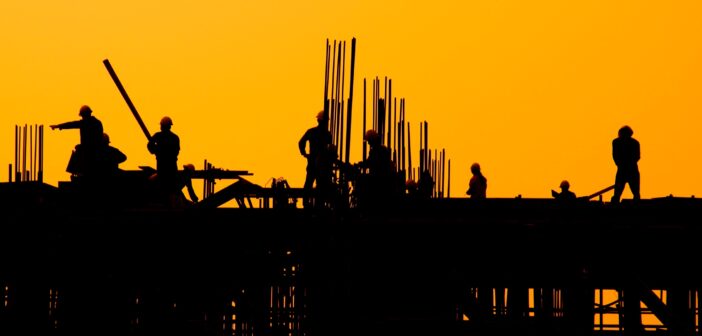Ram Kirpal is a construction worker in Noida. However, this daily wage earner is not a regular employee or even contractual worker with any real estate company or contractor. He goes back to his native place, Purnea in Bihar, on each harvest season and agriculture continues to be his main occupation. He works on construction sites in Noida only when there is no agricultural work back home. He is part of the bigger problem that the Indian real estate faces – labour shortage! A Track2Realty report.
This daily wage earner is not the only construction worker that is a part-time workforce for the Indian real estate in the top metro cities. These insecure & part-time workforce of the real estate companies are one of the major catalysts of project delays, as the builders more often than not cite the manpower shortage.
Take the case of Dwarkadheesh, another mason worker from Orissa, who has a peculiar dilemma of more wage versus higher cost of living. According to him, Noida builders pay him INR 300 per day and the cost of living is also low here. But in his quest to send more money back home, he wishes to work in Mumbai where the contractors are willing to pay INR 550 per day. But then the cost of living is so very high that he hardly saves any money while working in Mumbai.
Labour shortage is a real issue and the Indian developers in their collective consciousness have done little to address it. All the labour welfare schemes and training programmes have not worked beyond the lip service. Even the CSR (Corporate Social Responsibility) budget has hardly been channelised for attracting and retaining the labour force.
During Covid-19 lockdown the insensitivity of the developers was thoroughly exposed when the journalists were bombarded with the press releases of the developers feeding the labours. Shouldn’t that have been an intrinsic part of the CSR in the first place?
Some of the fundamental questions that the Indian real estate has to address for getting adequate manpower are:
Labour shortage is real in real estate. But is it an uniform problem across the markets or else there is city wise professionalism, or rather the lack of it?
Why certain markets/cities are more prone to face labour shortage and absence of skilled labour force?
What should be done by industry at large to avoid labour shortage?
Acceptance of labour shortage
The reverse migration in the first wave of Covid, post lockdown, has not been addressed in a manner that the labours could come back to work. This labour shortage is leading to a crisis of confidence on part of the home buyers as well since the project delays are inevitable now. While it will hurt the home buyers’ sentiments, it will also dent the bottom lines and profit margins of the developers. The vaccination and labour welfare, which ideally should have been an intrinsic part of the CSR, has not moved beyond the headline management on part of the developers.
The developers agree that the sector is confronted with the labour shortage. They nevertheless don’t have any concrete solution on the table. Aditya Kushwaha, CEO and Director, Axis Ecorp points out that the developers have been citing labour shortages on building sites and operating with less than half the workforce in many cases. Labour problems have plagued cities like Mumbai, and Delhi NCR, which are seen as expensive to live as against Noida, which has a catchment area where labour can stay. In smaller cities, labourers are more easily available than in the metros.
“Larger cities like Delhi, Gurugram, Mumbai, etc. depend on migrant labour. Most of the migrant labour departed after the second wave of Covid since they had little or no employment opportunities in that scenario. While things are beginning to improve, it is still not operating at full capacity. Memories of the abrupt lockdown and the mobility problems are still fresh in labourers’ minds. Plus, better opportunities and/or similar pay available near hometown have added to the woes,” says Kushwaha.
Vinit Dungarwal, Director at AMs Project Consultants maintains that there is a need to consider the labour shortage in India because 70 per cent of Indian office workers are experiencing greater work pressure. Labour shortage is present in India, across all the industries, not just real estate and across the markets. This is due to various factors like lack of housing, social security, and other amenities.
“The increasing number of unskilled labourers is a significant issue for the Indian labour market. Without sufficient vocational institutions, skill development among the country’s labour force is extremely slow. Many people with technical training are unable to find employment in the secondary sector, resulting in an enormous problem of educated unemployment in India. Add to these memories of the pandemic, which affected all industries with little or no employment possibilities, and the abrupt shutdown and mobility issues continue to cause concern. While economic reforms have been implemented, the country has slowly adopted crucial labour reforms,” says Dungarwal.
Genesis of problem
Currently, labour is hired through contractors and subcontractors. All of whom are hired on a contractual basis; hence there is no permanent labour force. Depending upon the contractor, quality and skill sets also vary. For the migrant labour, they are at the whims and fancies of these contractors. Their pay out is vastly reduced via this system.
While the government had announced measures to facilitate the return of migrant workers, such as the portability of ration cards under the One Nation One Ration Card (ONORC) program, which promises to guarantee that they receive PDS supplies at their urban locations (ration cards are tied to designated fair price shops).
Any solution?
To avoid the labour shortage issues that delays the housing projects, developers can look at offering upskilling options. Another way to incentivise migrant labour is by giving better benefits. Making sure that they have a place to stay close to the site or taking care of their children’s educational needs can go a long way in forming an emotional connection with the labourers and ensuring that they don’t pack up their bags and leave.
The industry bodies can also look forward to forge a partnership between the industry and the Government to help address this problem. The industry, for its own benefits, could look at upskilling the labour force to make them more valuable and other incentives such as attendance allowance, employment insurance, health coverage, travel expenses, greater minimum wages, and output incentives.
Some of the recent govt initiatives such as the four codes for labour laws which talks about reducing working hours and PF as well as the in-hand salary of employees in the process is expected to be implemented soon. With the new law, the Government intends to consolidate 44 core labour laws into four broad labour codes: code on pay; industrial relations; occupational safety, health, and working conditions (OSH); and social security. The industry can also offer incentives such as attendance allowance, employment insurance, health coverage, travel expenses, etc.
Ravi Sinha
CEO, Track2Realty
@RaviTrack2Media
Ravi Sinha is a journalist with over two decades of cross-discipline media exposure. He is the CEO of real estate thinktank group Track2Realty. He has been writing extensively on the real estate sector for more than a decade now. Evaluation of real estate brand performance is his core domain expertise and he has immense insight into consumers’ psychograph. He has conceptualised Track2Realty BrandXReport as India’s 1st & only objective & non-paid brand rating journal that is industry-accepted benchmark of brand equity & ranking of the Indian real estate companies.
Track2Realty is an independent media group managed by a consortium of journalists. Starting as the first e-newspaper in the Indian real estate sector in 2011, the group has today evolved as a think-tank on the sector with specialized research reports and rating & ranking. We are editorially independent and free from commercial bias and/or influenced by investors or shareholders. Our editorial team has no clash of interest in practicing high quality journalism that is free, frank & fearless.
Subscribe our YouTube Channel @ https://bit.ly/2tDugGl





